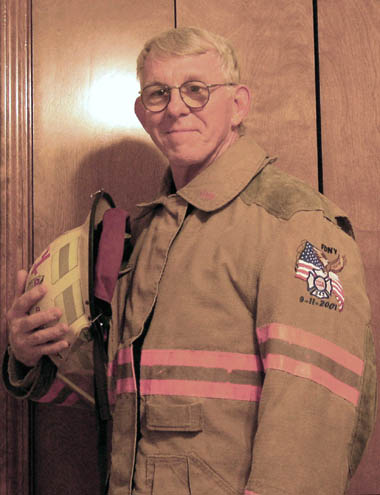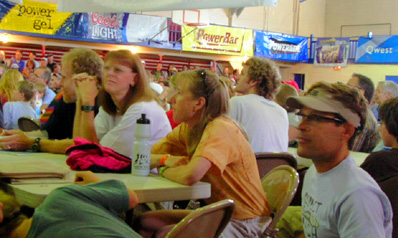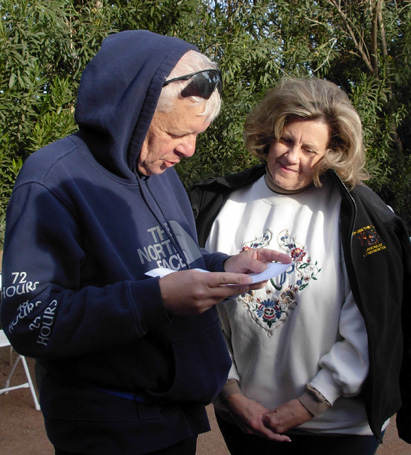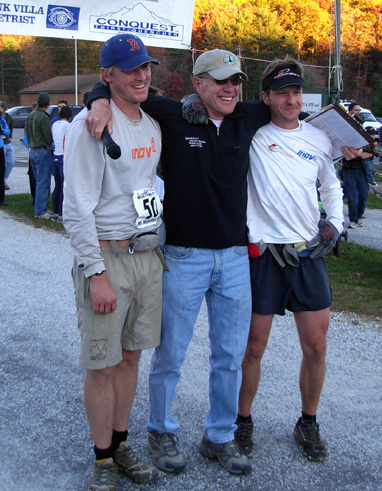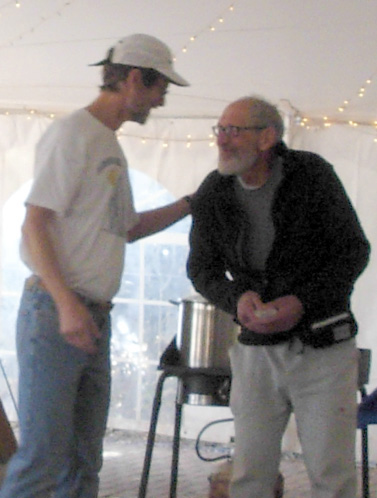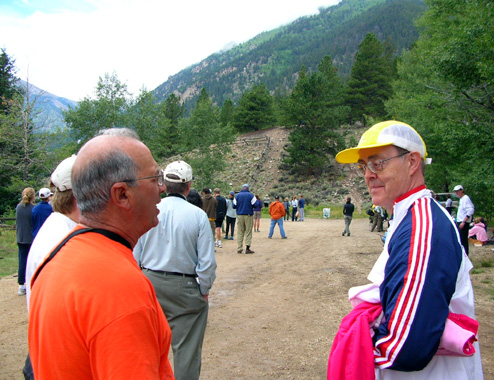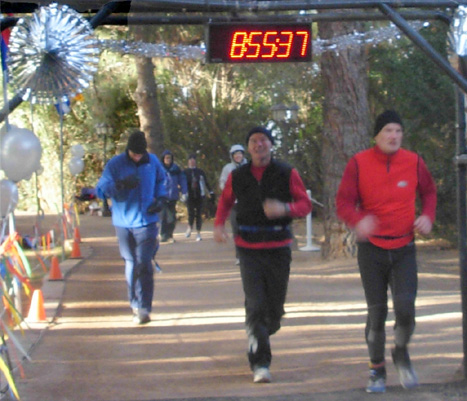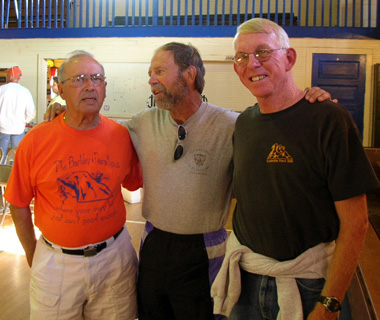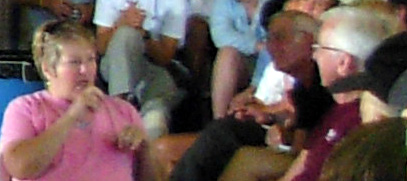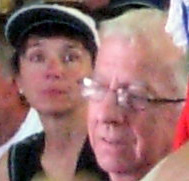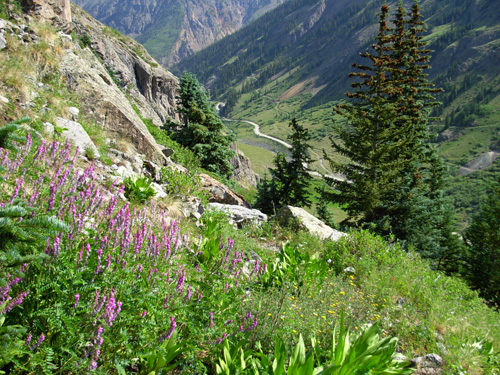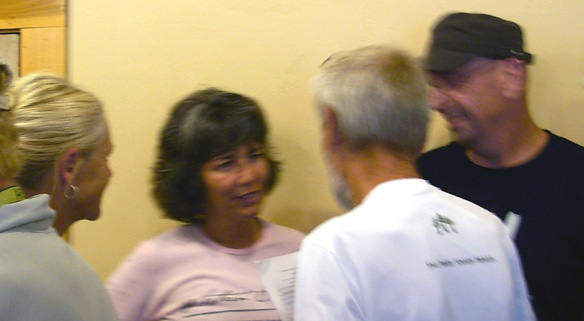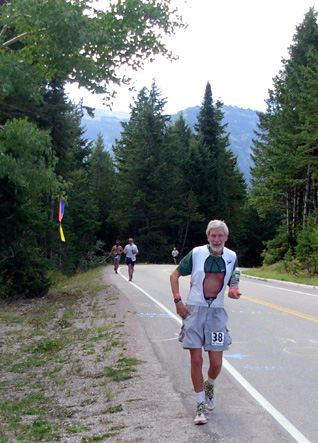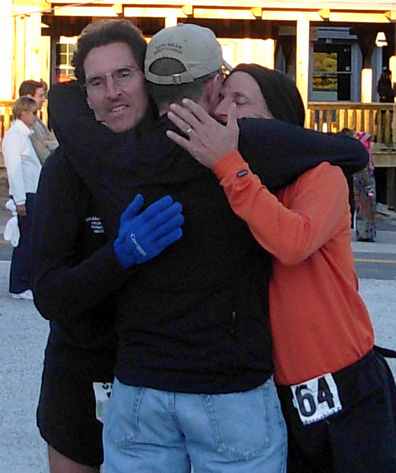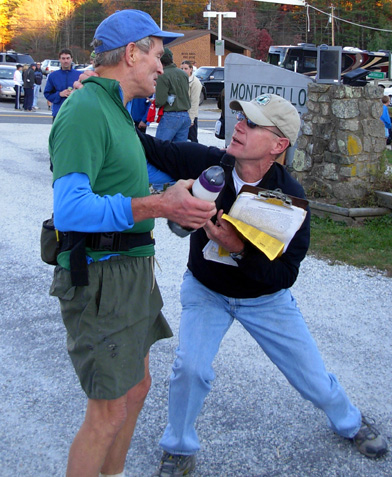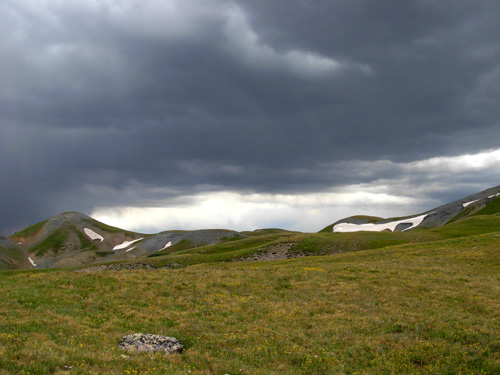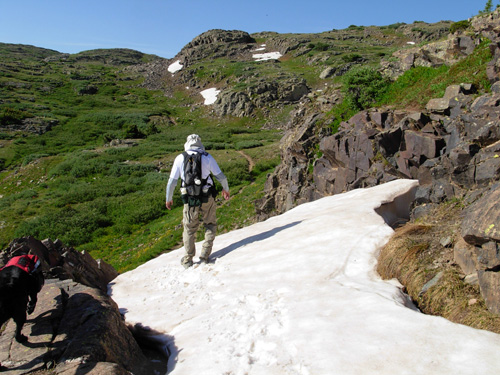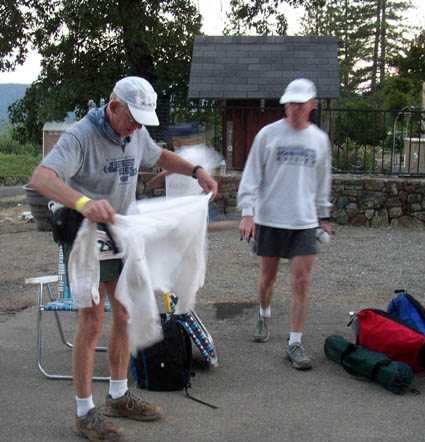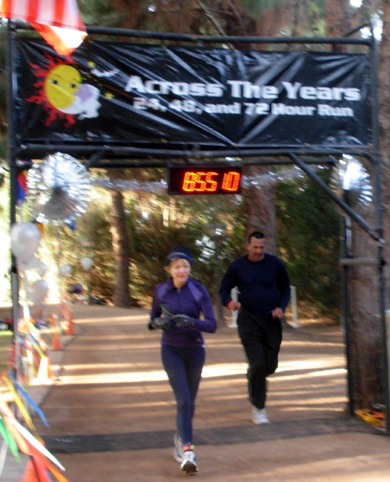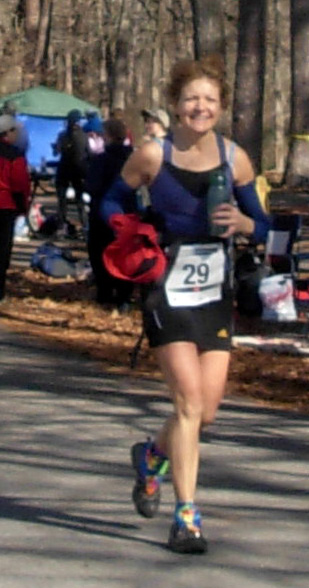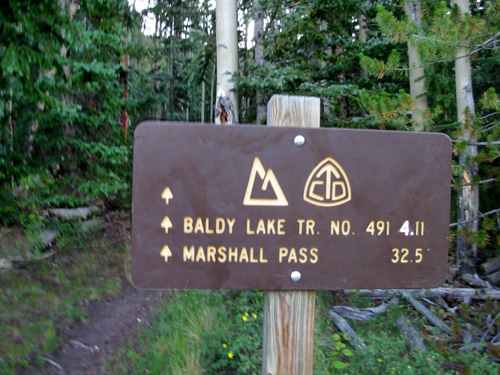|
2008 ULTRA RUNNING ADVENTURES
| ||
|
Runtrails' Web Journal
JULY 5
Heroes (and heroines) come in many forms.
There are the obvious heroes who risk their lives every day to
protect the rest of us -- people in the armed services, police
men and women, firefighters, other first responders, security
guards, etc.
There are ordinary citizens who perform heroic acts of bravery
in emergency situations, like rescuing someone who is drowning
or in another dangerous situation, also possibly risking their
own lives to save someone else.
There are heroes in professions as diverse as medicine and
music, heroes who triumph over villains in books and movies,
heroes who explored and built this country, heroes who fight for
the rights of others, heroes who help
strangers during disasters, sports heroes, and many other types
of heroes, some known to only a few they have positively
influenced (parents, e.g.).
Most heroes, after all, don't seek publicity or acclaim and may,
in fact, be embarrassed by either.
There are many people I admire for the reasons above but no one
has ever accused me of "hero worship" until recently. I'm much
too cynical to "worship" anyone, but I have a healthy respect
for many people who deserve the recognition of being a "hero," positive role model,
inspirational figure, whatever you prefer to call them.
I must say, few of them have been athletes. There are just too
many men and women in the world of sports who have abused our
trust and admiration, winning games, races, and titles through
cheating, fraud, drug enhancement, and other unethical means.
Unfortunately, some of them have been athletes in track and
other running events, The two who come into my mind first are
Rosie Ruiz, infamous for jumping into the 1980 Boston Marathon
about a mile from the finish and then claiming victory, and Marion Jones, who was stripped
of the five medals she won in the Olympics in 2000 because of
performance-enhancing drug use. There have been many others
through the years.
So, yeah, I carefully choose those who I consider to be my
"heroes" and if I later discover they really don't deserve the
designation, I'm initially disappointed. I develop yet another layer
of skepticism about humanity but forget about the imposters
pretty quickly. There are more who are honest and deserving of
admiration.
"That's what it takes to be a hero,
a little gem of innocence inside you
My list of athletes-to-admire greatly expanded after I
moved beyond the marathon distance sixteen years ago and began
running ultras. Now I've got all kinds of wonderful role models
and people who inspire me! There are several reasons for this, relating to
the nature of the sport and the type of runners who are drawn to
it.
For one thing, there is little or no money
to be won in ultras, so the incentive to cheat is minimized.
Despite the efforts of Dean Karnazes and his sponsors to
popularize ultra running, it's
still pretty much a low-profile, fringe sport with little publicity in the
mainstream media compared to other sports, or even to shorter
running events that are easier to televise. It's not even an Olympic event yet.
What's the point of cheating if there's little fame
or income to be gained?
There are some ultra cheats and frauds, but they are rare and
usually "outed" by their peers pretty quickly. The ultra
community is still comparatively small despite thousands of new
ultra runners in recent years, and word travels fast about the
scoundrels via the internet. Being ostracized and/or being
banned from future races are usually effective means of dealing
with problems of cutting courses, claiming to have set various
records that can't be verified, etc. (there is no drug testing
yet that I'm aware of).
Ultras also attract a different breed of athlete than marathons
and shorter running events. Ultra runners are
generally older, better educated, higher income, and more highly motivated people
who challenge themselves in every aspect of their lives. Ultra
running is one expression of their drive, not usually a career
in itself (only a few make their living from coaching, directing
ultras, etc.). It's another way for them to compete and excel. Most of
them are racing more against the clock and the elements,
however, than each other.
There's also more support of and concern for fellow competitors
than in shorter races, and those attributes seem to increase as the race
distance or level of difficulty increases. It's one of the most
appealing aspects of ultra running to me -- the level of caring
and respect shown to each other. It's still a rather small
"community." Most ultra runners will
sacrifice their own race in whole or in part to help another
runner in trouble -- give them fluids or electrolytes if they
run out, lend them extra clothing, walk with them to the next
aid station if they're having difficulties, stay with them if they're
injured, and so on.
Ultra running is a very different game attitude-wise than
marathons and other road races and that's what attracts many of
us to the sport. In addition to being more watchful of each
other, there's a unique level of respect for everyone who
attempts an ultra. Each of us can feel like a winner if we even finish
some of these events, let alone come in first. And the ones
who do come in first are usually very gracious about it
and appreciate / acknowledge the effort made by the slower
runners. Even a DNF commands respect because the other
competitors know how many variables there are in ultras and have
probably been unable to finish a race before, too.
SOME CHARACTERISTICS OF MY ULTRA RUNNING
"HEROES"
The ultra runners who inspire me the most, the ones I consider
to be excellent ambassadors and role models for the sport, share
one or more of the following characteristics. I'll list only a
few names as examples, but there are many more folks who share
these traits. I'm afraid I embarrassed three or four of them a
little bit recently when I listed them as "heroes" in a post to
the internet ultra list. Most true heroes don't see themselves
as such, although they can't argue about the attributes for
which I listed
them. Most are humble, genuinely nice people and I'm grateful to
call many of them friends.
1. ENCOURAGEMENT & SUPPORT
"Some people quietly make a
difference in our lives and will always be heroes unaware."
My first ultra running hero was
David Horton, and he still remains
near the top of my running heroes "list" some eighteen
years later (my husband Jim is #1, if you're wondering who's at
the very top!). If you've read my 2005 Appalachian Trail journal on
this web site you've seen David's name several times before.
Although I wanted to hike, then run, the AT since the late 1960s,
David was the first one whose account of an AT journey run in 1991
showed me it can be done and further inspired me to attempt it.
I had read a lot about David and his Mountain Masochist 50-mile
trail race (MMTR) in southeastern running magazines when I lived
in Atlanta. As I morphed from racing road marathons to trail
ultras I chose MMTR as my first ultra race. That was a
huge step, but one that David encouraged me to take. And I
did, placing 2nd female in the race in 1992 (that was before so
many more accomplished women started running it!). Like
many other newbies, I was instantly hooked on the sport. What a
feeling of accomplishment, which was reward enough for me.
David has inspired me through the intervening years as well. Not
only does he run very well, winning tough mountainous races like
Hardrock and the near-impossible Barkley "Marathons," running
across the USA in 1995, and setting speed records on both the AT
(1991) and Pacific Crest Trail (2005), David has also influenced more folks
to run ultras than anyone else until recently. (Dean Karnaze's
book, "Ultra Marathon Man: Confessions of an All Night Runner" has introduced
a lot of
people to the sport the last couple of years.) David has
mentored many student runners during his tenure as a physiology
professor at a college in Virginia, has developed a series of
four popular ultra races that he directs, and is very supportive of
ultra runners, especially those just beginning in the sport.
David was one of my biggest "cheerleaders" when I was on the AT,
even though he was setting his PCT record that summer in the
middle of my trek. He answered questions before I began, sent
numerous encouraging e-mails, and had a little presentation for
Jim and me at MMTR a few weeks after we finished our trek. I'll
never forget all he did. He also exhibits several of the remaining
characteristics of my ultra running role models below.
I could list many more ultra running friends and acquaintances
who have been supportive of my endeavors, but I'm sure to
inadvertently leave
out even more of them. I sincerely
appreciate their encouragement and I try to do the same for them
and others. They know who they are!
2. SEASONED VETERANS
As I near the end of my sixth decade of life, I have increasing
admiration
and respect for the men and women my age -- and especially older
-- who are
still "in the arena," folks like Dan Baglione and
Aaron Goldman in their 70s, Pete Stringer and Lynn David Newton
in their 60s, David Horton and my husband Jim in their late 50s.
They just keep pushing their personal envelopes and are positive
role models for the rest of us, regardless of their age or ours.
Older women especially inspire me because there are fewer of us
out there after our fifties than men. The number of women
running ultras really dwindles after age 60. Although the
percentage of younger women in their 20s, 30s, and 40s who run
ultras has increased in recent years, there's a much larger
percentage of male ultra runners who continue to run long
distances in their 60s and 70s than female ultra runners. It
seems to me that a lot of women stop running ultras in their
fifties. I think I know some of the reasons, but that's a topic
for another journal entry.
About a
month ago one of our friends, Dan Baglione, posted a report to the ultra list about a 50K he
couldn't finish. He has DNFd an increasing number of ultras as
he has gotten older, including ones like Barkley that few
younger runners have ever finished. Pete Stringer, who is about a decade younger,
wrote a typically thoughtful and supportive reply to the list
about how much Dan has inspired him. This is a part of his post:
"Dan Baglione was my main cheerleader when the dnfs at Leadville
began piling up, year after dismal year. He became an insistent
supporter, citing the number of attempts it took him before he
could find his way to the Sixth St. finish tape. He even sent me
his personal video of that triumph, even though he had only met
me in person, and that briefly, once (we live on opposite ends
of the country). It's guys like him that represent to me the
essence of the ultrarunner, much more about the indomitable
mindset than the shorter flirtation of a lot of fast fellas, who
are only here for the brief time that they can garner the top
ten spots."
Amen. Both Dan and Pete are two of my personal running heroes
for the same reasons. Pete didn't mention this, but he finally
finished Leadville a year or two ago.
Dan periodically updates a long list of folks over 70 who have
completed an ultra. You'd be amazed at the
number of septagenerians and octagenerians who have accomplished
this feat. His latest list includes 237 men and women, if I
counted it correctly. One of my favorites is Helen Klein, who is
86 now and still going strong. I'm not sure if there is anyone
in his 90s still doing ultras, but I know there are some men in
their 90s who run marathons. That is phenomenal.
Pete's quote mentions longevity in the sport. Although Helen
Klein didn't start running ultras until she was in her sixties,
most of the folks still running
them in their 60s, 70s, and 80s have been running various
distances for several decades. They definitely aren't "flashes
in the pan," quitting the sport after several years of fast
racing. These folks are in it for the long haul, running for the
enjoyment of the activity itself. Pete's post to the ultra list
says this very well, too, and leads me to my next attribute of
wonderful ultra running role models:
"I so appreciate Dan's posts as he grows older and keeps on
trying. I can only hope I love the sport as much! It is hard to
find posts of the older runners' dnfs as they they near the
place where not finishing becomes more the reality than a
finish. I loved the story of his attempt at The Barkley almost
as much as the original classic Don Quixote, and last year's
inimitable attempt at Badwater where he crewed himself,
laboriously returning to his car each time ...well,
Dan is too smart a guy to think there was much "percentage" in
that, but simply wanted to participate."
3. TENACITY
My ultra running heroes just don't give up. Dan and Pete are
good examples of this. Even though each has struggled to finish
Leadville and reach other goals, they keep on trying. Jim's like
this, too. Despite his DNFs at events like Leadville and Bighorn,
he continues to try to finish those difficult races. He believes
in himself and knows if he trains properly, stays healthy, and
hits good trail conditions and weather during the race, he can reach his
goals.
There's a woman in her sixties, Lucinda Fisher, who wanted so
badly to finish a 100-miler that she kept on trying and trying,
despite numerous DNFs at Western States and other moderately
difficult hundreds. Year after year she refused to give up her
dream. She kept training and trying. Finally, with coaching, a good training
program, lots of support, and tenacity she finished her
first 100-miler -- after DNFing fifteen times at other races! -- at the 2004
Javelina
Jundred. She was 63 years old. There's another person who's
tried to finish Leadville about the same number of times, but I
can't remember who it is.
These people inspired me to keep on
trying to finish just one more 100-miler. I truly
thought I could do it, too, until my Granny
knees gave out last fall (I'm still attempting as many
miles as possible in flatter 24-hour races).
4. OVERCOMING THE ODDS
"It is surmounting difficulties that makes
heroes."
The runners mentioned above have all tried to overcome the odds
of reaching goals that become more difficult as they age. Dan Baglione's
e-mail signature says a lot about him:
Run Long, Run Strong!
Exceed your expectations!
My ultra running heroes inspire me because of other odds they try to overcome,
too -- a disability or serious injury, a weight or other medical
problem, a particularly
difficult
goal, or another major challenge that would defeat most people
and relegate
them to the couch. My "heroes" may not always overcome those
obstacles but,
by golly, they have the optimism, determination,
self-confidence, and guts
to TRY.
Two I've met are amputees who have finished the Leadville
100-miler and other difficult events that are a challenge to
able-bodied men and women. Dan Jensen lost his right leg from
the knee down in Viet Nam. After being fitted with a
light-weight prosthesis, he's been able to run ultras and
Ironman-length triathlons. I believe he's in his 50s now. An inspiring younger man is
Aron Ralston, famous for
cutting off his lower right arm in 2003 after getting pinned
down by a boulder on a run in the Utah canyons. After five days
he realized help was not coming and he'd die if he didn't
literally take things into his own hand. The next year he
finished Leadville. He speed-climbed all of the Colorado 14ers
in the winter and he continues to climb mountains (with
one good arm) that challenge the country's best athletes.
Another ultra runner we're proud to have met is hearing-impaired
King Jordan, shown in the two photos above. King has finished Leadville several times in his 50s
and 60s (I'm unable to access the LT100 results to confirm the
number or dates). We were saddened to learn he didn't finish
last year, but he was still enthusiastic at the awards ceremony.
5. PUSHING THE ENVELOPE
"Without heroes, we are all plain people
and don't know how far we can go."
My ultra running heroes aren't certain what their limits are, so
they continually push their personal boundaries in an attempt to
see if they can run longer, faster, higher, whatever. They set
ever-increasing goals, trying to exceed their own expectations.
Sometimes they reach their goals, sometimes they don't. For some
it doesn't really matter if they gave it their best and they had
fun in the process. Often it's the planning and anticipation of
a new adventure that is the most fun! Having an interesting goal
makes training more fun, and executing it is the icing on the
cake.
I admire the folks who come up with interesting adventures
either for themselves or for others to also enjoy.
Their attempts, whether successful or not, inspire other runners
to reach or exceed similar goals.
Two of the more creative
endurance runners who come to my mind are Gary Cantrell and
Peter Bakwin. Gary is (in)famous for creating and directing his
near-impossible Barkley "Marathons" in the steep, briar-infested
Tennessee woods at Frozen Head State Park. Over the years only
five or six men have finished the entire 100 miles within the
60-hour time limit. Finishing only one 20-mile loop is a
"success" in most people's book. There are all sorts of weird
traditions in this race that have runners clamoring to try their
luck.
Peter has done a
number of interesting adventure runs alone or with his friend
Buzz Burrell or his wife, Stephanie Ehret in the U.S., South
America, and Europe. I'll never forget Peter's awesome double
Hardrock feat in 2006. He ran the difficult 100-mile loop
in one direction the two days before the official race, then ran
the race the 3rd and 4th days in the other direction (the course
changes direction each year). When Jim and I saw him at our aid station
during the "real" race, Peter was still running strong through
the high Colorado mountains 190 miles into his trek!
As Jim and I have increasing difficulty making cut-offs in ultra
races, we've come to appreciate creating our own ultra adventure
runs where the only limits are the ones we impose upon
ourselves.
6. EXTREME ENDURANCE
"Some of the world's greatest feats
were accomplished by people not smart enough to know they were
impossible." (unknown)
Several ultra runners win my admiration simply because of their
extreme endurance. They go 'way beyond "pushing the envelope."
I'll cite several examples of long trail runs/hikes,
transcontinental road runs, multiple 100-milers in a year, multi-day (and month!) races,
and
a multi-sport endurance specialist.
David Horton falls into this
category, of course, for completing a Trans America run (~3,000
miles) and setting records on both the Appalachian and Pacific
Crest Trails (2,168 and 2,650 miles, respectively). He calls
such adventures "Big Hairy Audacious Goals." I'll talk more
about his recent attempt to complete the even-more-difficult
Continental Divide Trail (CDT) in a bit.
Brian Robinson amazed everyone
in 2001 for his 7,371-mile Triple Crown speed hike in one
calendar year, completing the AT, PCT, and CDT in only 300 days.
I don't believe anyone has beaten that record yet. It's even
more amazing when you consider the problems David had on his
first day in the
desert of New Mexico on the CDT.
More and more runners are doing transcontinental runs on roads
across the USA and other countries. This is a good
web
site to read about some amazing performances and
follow folks doing trans-con runs this summer.
Two ultra runners that I swear are bionic are the delightful
Monica Schultz (above) and Hans-Dieter Weisshaar (shown better
below). In the mid 2000s each
completed over twenty 100-milers in a year's time -- for several
years. Monica, who is in her 30s, is a trial lawyer
in Canada. How she found the time to train and travel to all
these races in the States is beyond me.
Hans is even more
remarkable, in my estimation. He accomplished his amazing feat
of running numerous 100-milers several years in a row while in
his early and mid-60s. He completed his 100th hundred-miler last July at Hardrock, and kept right on running more of them later in the
year. The last race where we saw him was this past February at
Rocky Raccoon (at age 67). This summer the gregarious retired German physician is
competing in several ultras in Europe so he's less visible in
the States, but he's on the list for Hardrock again this month.
Another runner who inspires many people is Rob Apple, an affable
man in his late 40s who has run over 500 ultras. He's one of the
most prolific ultra runners in history. He's shown with David
Horton in the next photo at the end of last year's Mountain
Masochist race. That was #504 for Rob!
Then there are the (mostly European and Asian) runners who
specialize in multi-day events. I'm not talking mere 72-hour
events. I'm talking six-day, ten-day, and 3,100-mile events! The
latter is going on right now in NYC, if you want to take a
gander at this
web site. It's one of
the races in the Sri Chinmoy Marathon series. Even after
running/hiking the entire Appalachian Trail, I think these
people are 'way out of my realm. Imagine running around a little
loop in the city for up to 51 days, averaging over 60 miles a
day! That's some absolutely awesome endurance, both physically
and mentally. At least I had different scenery and terrain every
day on the AT.
Marshall Ulrich is an extreme ultra runner, adventure
racer, and mountaineer who appears to have no physical or mental
boundaries when you look at a list of his athletic
accomplishments. He remains a top competitor in his mid-fifties,
which should be inspiration enough for any person in these
sports disciplines. It's no wonder he's a motivational speaker.
He excels in extreme desert conditions such as the 146-mile
Badwater races and a 586-mile quad crossing of Death Valley,
competes in grueling Eco-Challenge races around the world,
summitted the highest peak on all seven continents on his first
attempt at each (including Everest), and has run over 100 ultras
averaging over 100 miles each. He's a nice guy, the real deal.
7. THE COURAGE TO QUIT "It is
not the critic who counts: not the man who points out how the strong man
stumbles or where the doer of deeds could have done better. The credit
belongs to the man who is actually in the arena, whose face is marred by
dust and sweat and blood, who strives valiantly, who errs and comes up
short again and again, because there is no effort without error or
shortcoming, but who knows the great enthusiasms, the great devotions,
who spends himself for a worthy cause; who, at the best, knows, in the
end, the triumph of high achievement, and who, at the worst, if he
fails, at least he fails while daring greatly, so that his place shall
never be with those cold and timid souls who knew neither victory nor
defeat." - Theodore Roosevelt, "Citizenship in a
Republic," Speech at the Sorbonne, Paris, April 23, 1910
That is one of my favorite quotes.
Sometimes it takes more guts to quit a race or record attempt
than it does to soldier on and finish. I believe that knowing
when one has reached his limits is a sign of wisdom and
character, not a sign of wimping out. DNF means not only "did
not finish" but also "did nothing fatal." Ultra running is a
sport, after all. There's not a lot of glory in pushing until
you incur permanent injury or death if you can pull out prior to
either.
This is the best and most recent example of one of my running
heroes having the courage to quit:
The first week of June I was writing an entry about David
Horton's attempt
this summer to set a new speed record running the very difficult,
2,959-mile long
Continental Divide Trail
(CDT). I wanted to direct
others to Clark Zealand's
web site about the journey run so they
could enjoy it vicariously, too. I was so excited for David and
wanted to be as supportive as I could from my home in Virginia.
I wanted to "give back"
as much support to him via e-mail and regular mail as he gave me
during my AT trek. I was disappointed that Jim and I couldn't be
out in Colorado and Wyoming again this summer to help crew for
him. That would have been very cool.
Clark listed ten post office addresses where David
planned to pick up mail along his route. David asked people to send
encouragement -- he knew he'd need it because of his daunting
task. I came up with a plan to
send hand-made cards to him at each mail drop with photos
of the CDT/CT that I took along the trail in 2006-7. I printed out
a bunch of photos and some
inspirational / motivational sayings to include with the
hand-written notes I'd write as he progressed along the trail. I
didn't want to write all of them beforehand, so I finished only
the first two cards initially. That way I could comment
specifically on
Clark's narrative about David's journey as he ran north to
Canada from Mexico.
Knowing David's tenacity and level of fitness for this adventure, I was
stunned late in the evening on June 7 to read Clark's post to the
ultra list, and longer entry in his blog about David's quest,
announcing that David's record attempt was over on Day One. He was so
beaten up by the New Mexican desert the first day that it was not only the
beginning but also the END of his CDT run. I felt as sad sitting
at my computer 2,000 miles away as if I'd been there in person
with him. I know how hard he trained for this, how much money
he'd already spent, how many people were planning to help him --
and how bad he must feel psychologically. At that point we knew he was in bad
physical shape after that day's run, but none of us except his
crew knew just how bad it was.
So when the second response on the internet ultra list to this
surprise announcement was a sneering post about David's attempt
being a record for the shortest speed record attempt (i.e., stopping
after only one day), I went ballistic. I wrote a terse comment
to the list about being more angry with that post than I'd ever
been in 10 or 11 years on the list and this person having no
clue about either David or the CDT, which is a very difficult
trail to follow. Other runners also jumped to David's defense
and we were soon accused of being "hero
worshippers." I was too angry at
the time to respond again on that thread, but a few days
later I posted what I consider to be admirable characteristics
of true ultra running heroes -- this journal entry is an
expansion of that post.
A month later, the opinions and emotions that surfaced
during that controversial thread sadden me more than anger me. I
don't personally know the guy who made the snide remarks. I do
know he doesn't have David's character, guts, or ability or he
wouldn't have been so eager to belittle David's stellar reputation
in the ultra community. The writer
subsequently tried to clarify his comments, saying he just wanted to analyze what
happened so it doesn't happen to anyone else. Maybe his intentions were
honorable, but his first post sounded inflammatory and ignorant to folks who
know David.
David is extroverted and loves to "egg people on" to encourage
them to run better. When they do well, he showers them in
praise. He doesn't brag about his own running ability, however.
This experience has made him
even more humble. In audio and video clips on Clark's site in
the hours and days following his decision to quit he apologized
to everyone who had helped him -- his crew, people who planned
to put him up along the way and/or run with him, folks who had
donated money for the record attempt, etc. He sounded tired and
looked worse in the
video taken of him on June 10, but a month later he is
healing both physically and psychologically. He is very grateful
for all the messages of support and understanding that he's
received via e-mail and on Clark's site.
8. ACCEPTING "DEFEAT"
"Many a man has
finally succeeded only because he has failed after repeated
efforts.
My ultra heroes know that there are important lessons to be
learned from adversity. In fact, we often learn more from defeat
than from victory.
Even in seeming defeat, David is a winner in my book. He used
extremely good judgment to stop when he did. He knows he could
have died out there in that hostile desert if he'd continued
running that day or the next. The
video that was taken soon after
he stopped on the first day (June 10) shows some of the physical
damage. I imagine it took more courage for him to stop than to continue.
He was wise enough to know that despite all his determination,
speed, and training, he wasn't trained to handle a poorly
marked trail in extreme heat with such long distances in the
desert without
water.
David swears he will never attempt the CDT again (or any
other desert run!) because the trail is so poorly marked in New
Mexico. He's very sorry he won't get to run it in Colorado,
Wyoming, Idaho, and Montana; running mountainous terrain
is his forte. I've encouraged him to do more of the CDT someday
when he can run at a more leisurely pace and see the beauty of
the mountains.
In true "hero" fashion, however, David continues his
never-ending quest to push his boundaries. He's already planning
his next challenging adventure, although he won't tell us what
it is yet. My ultra running heroes don't let a setback like a DNF
or failure to reach a particular goal defeat them. They may
go through some or all of Kubler-Ross' five stages of grieving
(denial, anger, bargaining, depression, acceptance), but they
move through them pretty quickly to the acceptance stage -- and
get on with the next challenge! Their pity party is over before
the guests even arrive.
9. GRACIOUS UNDER ADVERSITY
"Hard times don't create heroes.
My ultra running heroes know how to roll with the punches and
keep their cool. They don't let adversities like bad weather,
injuries, illnesses, crew defections, race cancellations, course
sabotage, and other challenges get them down for long. They
realize "stuff happens" and they make the best of it.
In late June about four hundred entrants in the
prestigious Western States 100-mile run were put to the test.
Each one had beaten the worst odds (about one in six) in the
race's 35-year history to win a coveted spot on the entrants' list. Some
had tried to get into the race for several years before finally
being chosen for this year's race. Each
one had trained for six months or more to finish the race --
many hours, many miles, much time away from their families. Each
one had plunked down a bunch of hard-earned money for the
opportunity to run this famous course. Many planned to bring
along their families or friends as crew and pacers. Plane and
lodging reservations had been made months in advance. Serious
tapering had begun. They were ready and raring to go.
A record thirty-seven of the entrants were going to attempt the Grand Slam
this summer. Western States is the first of the four-race series
they'd entered in advance, one right
after the other from June to September, in California, Vermont,
Colorado, and Utah. Four entry fees already paid, four or more
plane fares paid, four lodging reservations made. For some older
runners like 71-year-old Karsten Solheim, it might be their last realistic
chance to attempt the Slam.
Mother Nature intervened a few days before the June 28, 2008 running
of the Western States 100. Lightning from numerous thunderstorms
started hundreds of forest fires in the parched California
mountains. Two that raged out of control were so close to the
Western States course that race organizers announced three days
before the race was to begin that it would have to be cancelled
for the first time in its 35-year history. The air wasn't safe
for runners to breathe and firefighters didn't need to be
hindered by hundreds of crews and their vehicles on the narrow
roads to several of the aid stations.
Some of the runners
and their families were already at Squaw Valley for the pre-race festivities
when they heard the news. Others around the country -- and world
-- were in transit or ready to travel.
Just imagine how disappointed you'd be after so much
anticipation, training, and expense. Talk about being "all dressed up
and nowhere to go!!" Jim and I have had that feeling and
know how frustrating it is when we've DNFd a race we've trained
hard for. We usually try to find another one pretty quickly
while we're still trained, to redeem ourselves. It's hard for
even us to understand the full impact on the runners who didn't
even get the chance to start Western States this year.
We've never had to deal with a race being cancelled.
There was quite a range of emotion
expressed on the internet ultra list, more from people
empathizing with the runners than from the runners themselves
-- most of them were more preoccupied with their dilemma than those who
were sitting in front of their computers at work or home! The
situation raised more questions for the runners than answers in the first few
days -- now what? is there another race I can do soon? can I get
off work again? can I cancel my reservations? will I get my
money back from States? will I get into States next year? what
about the Grand Slam? Non-participants wanted to know the
answers, too.
Juli wrote such a positive report to the ultra
list about her experience that I wrote back to her off-line and said I
want to be like her when I grow up! She got a kick out of that
because I'm nine years older. Although she's disappointed she
can't run Western States this year, she still has the
opportunity to get in automatically next year and she can still
run the Grand Slam this year. A fourth race, Arkansas Traveler,
has been designated as this year's substitute for Western
States. So all those other race entries haven't gone down the
drain for the Slammers, as long as they can run AT100 in
October.
Ultra runners who can adapt by "making lemonade out of lemons"
when life hands them a raw deal are heroes to me. I am inspired by their
graciousness and positive attitude. These people aren't the ones
who become angry and blame others for their setbacks. They don't
bitch and moan publicly. They are justifiably disappointed, but
they grumble privately (if at all), deal with reality, make
adjustments, set new goals, and go after them. If only everyone
(including me) could respond to adversity in this manner!
10. SETTING RECORDS, "FIRSTS," OR "MOSTS"
"Heroes take journeys, confront dragons, and discover the
treasure of their true selves."
You may have noticed that I didn't include a category for the
folks who win ultras. It's not that I don't admire their ability
to run the fastest on a particular day in a particular race. I
do admire their ability but it's a criteria that's very
low on my list of who inspires me or who I consider a "hero.".
However, I am inspired by the men and women who
consistently win races or place near the top, especially if
they can do it for lots of years. I'm thinking
of Ann Trason's awesome winning streak at Western States
(something like fourteen times), Tim Twietmeyer's long record of sub-24-hour finishes in the same
race, and Bill Finkbeiner's lengthy streak at Leadville. These
are tough races and to run this well for one, two, or almost
three decades is remarkable.
I'm also impressed by long trail and mountain peak speed
records, although my own style on the Appalachian Trail and
Colorado Trail was to go slowly enough to enjoy the journey and
not rush, rush, rush every day. David's records on the AT and
PCT are impressive, as are Andrew Thompson's on the AT and Jonathan
Basham's on
the CT -- but did they really have much FUN going so fast??
What did they miss when they were running in the dark? For that
matter, what did they miss in daylight by going so fast?
Still, their feats inspired me when I was still able to run and
hike mountainous terrain for days and weeks on end (those days
are over for me now, unfortunately) and I continue to admire their ability to get
out there day after day and cover those distances so quickly.
Another guy who's set lots of amazing ultra running, hiking, and
mountain climbing records is Ted "Cave Dog" Keizer. You can
check out his
web site here. Peter
Bakwin is in the process of setting up a web site regarding
such records
here -- he's included
lots of long trails and 14ers. Those sites should keep you
busy for a while!
ARE YOU SOMEONE'S HERO?
"I think we're all heroes, if you
catch us at the right time."
I like that quote -- it's very optimistic and upbeat. I do
believe most of us are capable of heroic acts of one sort or
another throughout our lives. There are many ways to motivate
and inspire others by the way we live our own lives and by the
way we treat other people. You certainly don't have to be an
endurance athlete to be a positive role model. Although I've
written about characteristics I value in ultra runners I know
personally or have read about, most of these attributes are
shared by the other types of "heroes," too.
Think about who your heroes are, and why. Do you share any of
those traits? Then you're probably someone else's hero and don't
even reailze it!
Aspiring to inspire,
Sue
© 2008 Sue Norwood and Jim O'Neil |
|||

